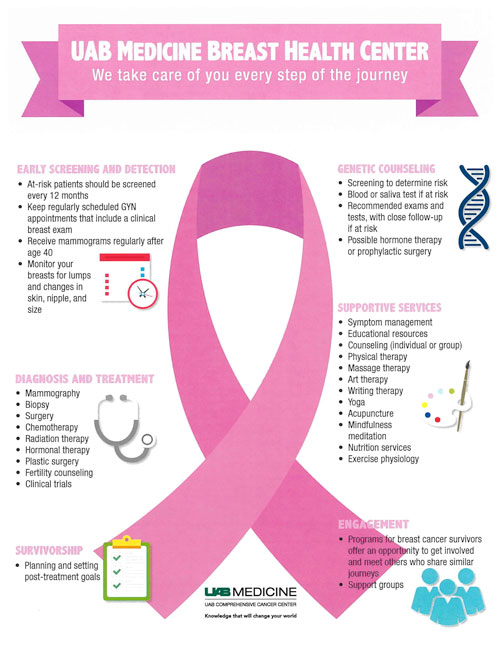 Click to enlarge.According to the American Cancer Society, there will be 252,710 new cases of invasive breast cancer among women in the United States this year. Finding breast cancer early is one of the most important strategies to prevent death from the disease. When breast cancer is found early, it is small and has not spread, making it easier to treat successfully and necessary for women to be aware of breast health all year long.
Click to enlarge.According to the American Cancer Society, there will be 252,710 new cases of invasive breast cancer among women in the United States this year. Finding breast cancer early is one of the most important strategies to prevent death from the disease. When breast cancer is found early, it is small and has not spread, making it easier to treat successfully and necessary for women to be aware of breast health all year long.
“Despite the magnificent strides in breast cancer research, women still need to adhere to screening guidelines recommended for their age group, especially if they have a family history of breast cancer,” said Catherine Parker, M.D., a fellowship-trained breast cancer surgeon at the University of Alabama at Birmingham. “The good news is that we’re living in a time when women are surviving the disease. In fact, the population of survivors is expected to grow. However, we still need to be vigilant and take measures to protect ourselves.”
The ACS recommends that women who are at average risk for breast cancer start getting mammograms yearly at age 45, but they have the choice to start having annual mammograms at age 40. Women 55 and older should switch to mammograms every two years, or continue yearly screening.
“Mammograms do not detect every breast cancer,” Parker said. “Women at every age should be familiar with how their breasts normally look and feel, as well as be familiar with signs and symptoms of breast cancer.”
Although there are differing opinions about the benefits of breast self-exams, it is important — starting in their late teens and early 20s — for patients to know the proper technique, what to look for and what is their normal. For example, if one breast has always been smaller or if one nipple has always turned inward.
The most common symptom of breast cancer is a new lump or mass in the breast. A painless, hard mass that has uneven edges is more likely to be cancer; but breast cancers can be tender, soft or rounded. For this reason, it is important to have any new breast mass, lump or change in the breast checked by a health care professional.
Other possible symptoms of breast cancer include:
- Swelling of all or part of a breast, even if no distinct lump is felt
- Skin irritation or dimpling of the skin
- Breast or nipple pain
- Nipple retraction or turning inward
- Redness, scaling, or thickening of the nipple or breast skin
- Nipple discharge other than breast milk
For women who have a family history of breast cancer, the UAB Breast Health Center offers comprehensive guidance on risk assessment, genetic testing, screenings and prevention strategies. The center takes a multidisciplinary approach to cancer care. When patients are diagnosed with breast cancer, they are immediately assigned a team of specially trained breast cancer experts, including a medical oncologist, radiologist and surgeon, who are able to give them individualized recommendations regarding their diagnosis, treatment, surgery and recovery. The clinic is also able to offer first and second opinions for any problems related to the breast.
“The program is also able to offer screening and clinical management for women who have an increased risk of both ovarian cancer and breast cancer,” Parker said.
For more information about early detection and screening, click here.